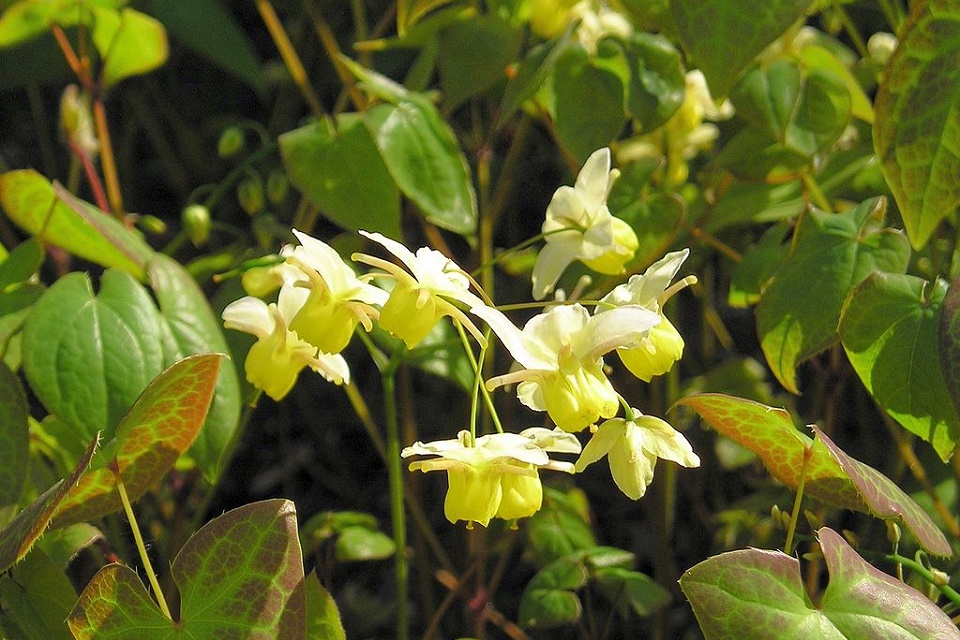
The Perfect Plant for a Shade Garden
From the UT Gardens
March 2016 Plant of the Month: Barrenwort
Submitted by Sue Hamilton, Director of the University of Tennessee Gardens
Bishop’s cap, barrenwort or fairy wings, as it is commonly called, is the perfect plant to add to any shade garden. This often over-looked perennial, botanically known as Epimedium, is oh so easy-to-grow and its tenacious habit provides a welcome first breath of spring with its airy flowers followed by a solid backdrop of attractive foliage.
A member of the mostly woody barberry family, Berberidaceae, barrenwort blooms in March to April and comes in a kaleidoscope of colors including white, yellow, purple, orange, red, and many shades in between giving the gardener a broad palette to add to a shady landscape. Epimedium is commonly called bishop’s hat because the four-parted, spider-like flowers resemble a clergyman’s hat or miter.
Barrenwort is found throughout the world, with the greatest concentration found in China. The 50+ species that have been cultivated and hybridized for more than 150 years in Europe (even longer in Japan) all prefer shady woodland, scrub, and rocky places. Barrenwort’s growth habitat ranges from dense mounds to wide-spreading ground covers. “Ground-cover for dry shade” is a common characterization; however, the vast majority of species are clump forming and all of them prefer adequate moisture and well-drained, humus-rich soils. Those selections which most often make the dry shade ground-cover cut include E. × rubrum, E. × versicolor ‘Sulphureum’ and E. × perralchicum ‘Frohnleiten’. These selections are drought-tolerant only after they become established.
The often heart-shaped or arrowhead-shaped foliage distinguishes barrenwort from other shade-loving perennials. Foliage can be evergreenor deciduous, depending upon variety. Evergreen leaves with good substance usually maintain their color until spring. But some foliage suffers some winter burn and plants will look their best with such foliage pruned. The leaves of deciduous varieties dry up and either blow away or hang limp with the first few frosts of the season.
The foliage and blooms of many barrenworts are among nature’s first flush of color early in the spring. After they harden off, they will then produce a second layer of new spring foliage, with the same beautiful colors that they first displayed. If the weather brings a long, cool spring, barrenworts can linger with up to six weeks of coloful flowers and new spring growth. After a green summer, barrenworts sport fall foliage with beautiful shades of yellow, red or bronze, making them a major player in the autumn landscape.
Barrenwort makes a great companion for bulb plantings and later serves as an effective cover-up for declining daffodil and tulip foliage. Because of its low height, it lends itself well to being planted in the foreground of a garden. Heights range from 6 inches to 2.5 feet, but are most commonly from 12 to 18 inches. Clump forming types usually mature to a plant that is as wide as it is tall.
Barrenwort is cold hardy to at least Zone 5 and heat tolerant to Zone 8. For Mid-South landscapes select varieties that have been rated as heat tolerant.
Barrenwort is really an indispensable plant for any gardener. With so many wonderful attributes – great flowers and foliage, deer-resistance, low-maintenance, and tolerant of dry shade – this plant should earn a spot or even two, in any garden. For more information, check out the website epimediums.com. You can also see some specimens in bloom at the UT Gardens, Jackson, near the gazebo.
The UT Gardens includes plant collections located in Knoxville, Jackson and Crossville. Designated as the official botanical garden for the State of Tennessee, the collections are part of the UT Institute of Agriculture. The gardens’ mission is to foster appreciation, education and stewardship of plants through garden displays, educational programs and research trials. The gardens are open during all seasons and free to the public. For more information see the Gardens website: http://utgardens.tennessee.edu
Contact:
Susan Hamilton, UT Department of Plant Sciences